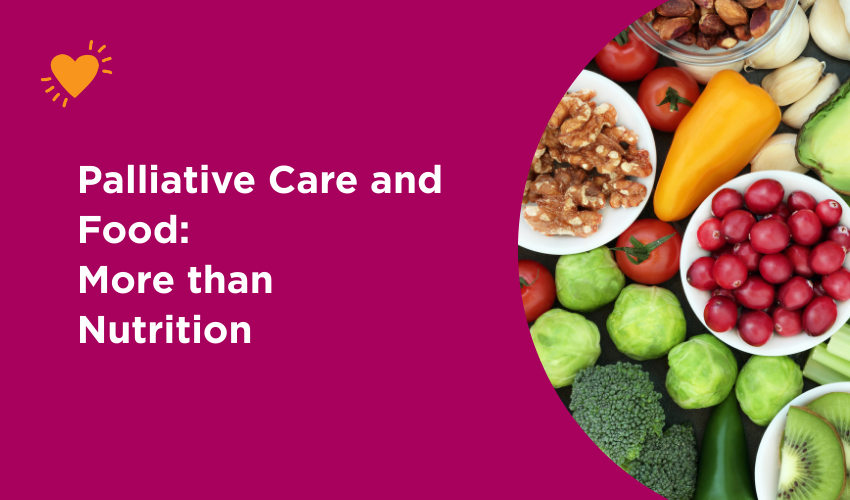Food is more than fuel. A new study reminds us that meals can be about love, comfort, culture, and connection – especially in palliative and aged care. With food and dining now a dedicated focus in the strengthened Aged Care Quality Standards, we unpack why food is central to rights-based, person-centred care and what the latest reforms mean for residents, families, and providers.
When we think about food in health and aged care, the conversation often starts and ends with nutrition: calories, vitamins, and dietary requirements. But as anyone who has shared a meal with family or friends knows, food is rarely just about fuel. It can connect us to our culture, identity, and memories. It is how we show love and care. And in palliative care especially, food can be a source of comfort, joy, and dignity.
A new Canadian study by Wicks and colleagues (2025) explored the significant role food plays in person-centred palliative care. Their research looked beyond the science of nutrition to understand the emotional and social meaning of food for people receiving palliative care, their families, and staff. Their findings reinforce what many of us instinctively know: the role of food changes over the course of the palliative journey, and it deserves far more attention in care planning.
What the research tells us
The study found four common ways food is experienced along the palliative care journey:
- Early on, food is functional, about maintaining strength, managing symptoms, and maintaining independence.
- As illness progresses, food takes on a deeper meaning as a source of comfort, cultural connection, and memory. Carers often go to great lengths to provide their loved one food that feels like “home,” even when hospital kitchens cannot always provide it.
- Near the end of life, when nutrition is no longer a priority, food becomes about small pleasures and final celebrations. Even a sip of a favourite drink or taste of a comfort food can bring dignity, joy and connection.
- When eating is no longer possible, food may become a source of conflict or grief. Carers may struggle navigating loss of food as a means of expressing love and care. Staff face the challenging task of supporting carers through this transition which can be especially difficult where cultural backgrounds, desires, and expectations differ.
The researchers also highlighted a disconnect between hospital food service systems and the lived realities of patients and carers. Requests for culturally relevant meals were sometimes ignored, or not even possible within existing hospital processes and systems. Staff, meanwhile, often felt underprepared or unsupported to have difficult conversations about food and appetite changes.
Importantly, while this study was conducted in a hospital-based palliative care unit in Canada, the findings are highly transferable to in-patient palliative care units as well as aged care in Australia. After all, palliative care is core business in residential aged care, and food and the dining experience, as we know, can significantly impact the quality of life of residents, and the experience of families and carers.
Food, rights, and aged care reforms
The Royal Commission into Aged Care Quality and Safety made clear that food in aged care was an area in urgent need of improvement. In response, food and nutrition have been given significant prominence in the new Aged Care Quality Standards for both residential and in-home aged care which will take effect on 1 November 2025 alongside the new Aged Care Act. Standard 6 focuses specifically on food and nutrition. It recognises access to nutritionally adequate food is a fundamental human right but goes further by requiring providers to engage with older people about what and how they like to eat and drink. It also calls for real choice, meals that are nutritious and appetising, and dining experiences that foster comfort and belonging, even for those requiring texture-modified diets.
Standard 6 also highlights the importance of providing an enjoyable and culturally safe food and dining experience, noting that if the dining experience itself is poor or food is not responsive to social and cultural needs, residents may be less inclined to eat at all. This points to food as more than sustenance: it is an experience that reflects identity and fosters inclusion, belonging, and dignity. For many people receiving palliative care, sharing food and drink with carers, and family is an important source of comfort and connection.
Beyond end-of-life care
Linking the Wicks et al. study with the reforms into Aged Care highlights another important point: palliative care is not just end-of-life care. Although it is not always linear, it generally begins at diagnosis and follows a person through their journey, often for months or years, across various healthcare settings. The role of food, too, evolves along the way, from nourishment, to comfort, to celebration, to memory. Recognising and supporting these shifts is part of quality, person-centred care, whether in a hospital setting, a hospice or in-patient unit, or residential aged care facility.
This highlights the importance in investing not only in appetising and culturally appropriate food and dining experiences, but also in training and supporting staff to navigate challenging conversations with carers around food and appetite changes.
Food and the dining experience are central to quality of life and equity in person-centred palliative care and aged care. If you have questions about how the new aged care reforms or food and nutrition standards may affect you or your loved one, we encourage you to speak with your care provider. And as always, Palliative Care NSW is here to share resources and highlight reforms that put dignity, comfort and person-centred care at the heart of the system.
Written by Sarah Whiteley.


